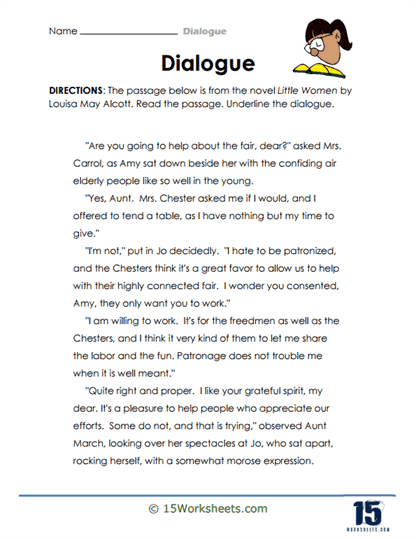

Imagine if you were a character in your favorite video game, book, or movie, and you had to have a conversation with another character. Now, think about all the things you might say and the responses you might get. A dialogue worksheet is a tool to help you brainstorm and structure these kinds of conversations in real-life or even for writing stories.
So, how does it work? They consist of two columns. On one side, you write down what one person says, and on the other side, you write the response from the other person. It’s like writing a script for a play or a movie!
Let’s imagine you’re writing a story about a magical adventure. Your main character, let’s say his name is Bob, finds a hidden treasure map. He’s excited and wants to show his best friend, Sally. Here’s how you might set up your dialogue worksheet:
| Bob (Speaking) | Sally (Responding) |
| “Sally, look what I found! A hidden treasure map!” | “Really? Show me, Bob!” |
| “Look, the treasure is hidden in the Enchanted Forest!” | “The Enchanted Forest? That’s a dangerous place, Bob.” |
| “I know, but think about the adventure! We could become famous!” | “Hmm… okay, but we need to prepare first.” |
See how the conversation goes back and forth? You can also add more details like the tone of voice or emotions. For example, Bob might be “excited” or Sally might respond in a “worried” tone. It’s a great way to make your dialogue more realistic and engaging.
Using a dialogue worksheet is like playing ping-pong with words! It’s about more than just the words though, it also helps you understand how people react and respond to each other in different situations. That way, you can create more believable characters and conversations in your stories, or learn how to respond better in your own conversations.
Dialogue is a literary technique that represents a conversation between two or more characters in a written work, such as novels, short stories, plays, or films. Dialogue is an essential component of storytelling, as it allows characters to express their thoughts, emotions, and intentions, while also driving the plot forward and revealing aspects of their personalities.
In written works, dialogue is typically presented as lines of text enclosed in quotation marks and often accompanied by dialogue tags (e.g., “he said,” “she asked”) to indicate the speaker. In plays and screenplays, dialogue is formatted differently, with character names followed by their spoken lines.
Dialogue serves several important functions in storytelling, including:
Character development: Dialogue can reveal a character’s personality, background, beliefs, and motivations through their speech patterns, word choices, and tone.
Plot advancement: Conversations between characters can move the story forward by revealing critical information, creating conflict, or resolving issues.
Atmosphere and setting: Dialogue can help establish the time period, location, and cultural context of a story through the characters’ accents, slang, and references to specific events or places.
Relationship dynamics: Conversations between characters can showcase their relationships, power dynamics, and emotional connections, providing insight into their interactions and bonds.
Tension and conflict: Dialogue can create tension and conflict between characters, as they express opposing viewpoints, argue, or engage in verbal battles.
Effective dialogue should be engaging, believable, and true to the characters, helping to create a more immersive and captivating reading experience.
The point of dialogue in literature, plays, or films is to serve multiple purposes that contribute to the overall storytelling experience.